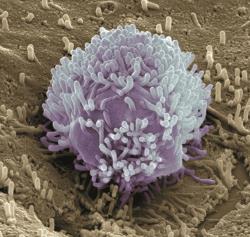 Molecular Subtypes of Colorectal Cancer Linked to Outcomes
Molecular Subtypes of Colorectal Cancer Linked to Outcomes
Two studies published simultaneously in Gastroenterology took in-depth looks at molecular subtypes of colorectal cancer and came to similar conclusions—that combinations of the same molecular markers are good prognostic indicators of disease progression, and that certain subtypes are associated with better or worse survival outcomes (Gastroenterology 2015;148;77–87 and 88–99). Together, the studies point to avenues of research to: better understand the biological basis for these survival differences; use the marker combinations as predictive and prognostic indicators in colorectal cancer; and consider the subtypes in treatment selection, according to the authors.
Both research teams sought to look for associations between molecular subtype and colorectal cancer survival because prior research has implicated underlying heterogeneity in the disease. In addition, patients diagnosed at the same stage and with similar histology have different clinical outcomes.
The tumor marker pathways involving microsatellite instability (MSI), CpG island methylator phenotype (CIMP), and BRAF and KRAS mutations all have been studied and associated with differences in survival. However, molecular subtypes of these markers and their association with survival have not been investigated extensively.
One research team did a secondary analysis of a randomized, controlled chemotherapy trial of 2,720 stage III colorectal cancer patients. The other analyzed samples from 2,050 participants in the Seattle Colon Cancer Family Registry who had been diagnosed with invasive colorectal cancer between 1998 and 2007 and were followed for survival through 2012.
The teams both identified five colorectal cancer subtypes based on combinations of MSI, BRAF, and KRAS mutation status, with one team also considering CIMP. These types include: 1) MSI-high, CIMP-positive, BRAF-mutated, KRAS-wild type; 2) MSI-low, CIMP-positive, BRAF-mutated, KRAS-wild type;
3) MSI-low, CIMP-negative, BRAF-wild type, KRAS-mutated; 4) MSI-low, CIMP-negative, BRAF-wild type, KRAS-wild-type; and
5) MSI-high, CIMP-negative, BRAF-wild-type, KRAS-wild type.
The teams found that type 4 tumor subtypes, which comprised approximately 47–49% of cancers in the studies, had the best survival rate and were considered the referent population. In comparison, subtypes 1 and 5, both with high-MSI and wild-type KRAS, had more favorable outcomes. In contrast, subtypes 2 and 3, which both had low-MSI, had relatively poorer outcomes.
Together, the studies “advance some new and important associations between molecular alterations and patient survival,” according to an accompanying editorial (Gastroenterology 2015;148:10–3). “Both groups found, with remarkably similar percentages for subgroups” that analysis of MSI status, CIMP status, and KRAS and BRAF mutation status were informative for colorectal cancer-specific mortality. “The findings offer further evidence that studies of the intertumor molecular heterogeneity of [colorectal cancers] has merit and value,” concluded the editorial.
Paper Spray Mass Spectrometry Fast, Accurate in Monitoring Tacrolimus
Researchers at Stanford University and Indiana University recently reported a new method for monitoring tacrolimus drug level in blood and found that it provides “accurate results … with rapid turnaround time amenable to random access testing protocols” (Clin Chim Acta 2015;441:99–104).
The authors explored the use of paper spray-tandem mass spectrometry (PS-MS/MS) in measuring tacrolimus to see what advantages it might have over existing methods, including automated immunoassays and liquid chromatography-MS/MS.
Automated immunoassays provide results rapidly, but are not standardized across platforms and may have cross-reactivity with tacrolimus metabolites which can lead to serious over-estimation of tacrolimus concentration. Some also require manual sample preparation.
LC-MS/MS methods have better specificity and lower reagent costs, but require more specimen pre-treatment and almost always are done in batches, which slows turnaround time. In contrast, PS-MS/MS generates gas phase analyte ions directly from dried blood spots without extensive sample pretreatment and chromatography, shortening turnaround times.
The researchers evaluated PS-MS/MS in a clinical laboratory, using real patient samples. They took several actions to validate the method, including assessing intra- and inter-day imprecision and analyzing patient samples with known tacrolimus concentration every day for 3–5 days to develop a precision profile. The investigators also compared PS-MS/MS with validated immunoassays and LC-MS/MS assays, including one at a reference lab.
The authors reported that PS-MS/MS had an analytical measurement range of 1.5–3.0 ng/mL, and inter-day imprecision of 13%, 8%, and 5% at tacrolimus concentrations of 4.5, 10.5, and 24.5 ng/mL, respectively. The r2 correlation with immunoassay and LC-MS/MS was 0.99 and 0.94, respectively.
Elevated TIMP-2, IGFBP7 Early in Critical Care Tied to Long-Term Risk of Mortality, Kidney Transplant
Tissue inhibitor metalloproteinaise-2 (TIMP-2) and IGF-binding protein-7 (IGFBP7) measured early in critical illness are associated with long-term risk of mortality or renal replacement therapy (RRT)
(J Am Soc Nephrol 2014;26:10.1681/ASN.2014060556). The findings suggest that routine measurement of these biomarkers may help to identify critically ill patients who are most at risk for adverse outcomes, according to the authors.
The investigators examined TIMP-2 and IGFBP7 as part of the Sapphire study, which involved 744 critically ill adult patients at 35 sites in Europe and North America. Subjects were enrolled in Sapphire within 24 hours of entering intensive care units (ICU), had respiratory or cardiovascular dysfunction, and were expected to be in ICU with a urinary catheter for at least 48 hours. The current study, a secondary analysis from Sapphire, looked at the association of TIMP-2 and IGFBP7 levels upon ICU admission and a 9-month composite end point of all-cause mortality and/or RRT.
The researchers used immunoassays and an associated meter which converts the fluorescent signals from the immunoassays into a single numerical result. They used predetermined TIMP-2/IGFBP7 cutoffs for development of acute kidney injury (AKI) of 0.3 for high sensitivity and 2.0 for high specificity.
Of the 692 subjects for whom baseline TIMP-2/IGFBP7 values were available, 55% developed stage 1 AKI within 72 hours of enrollment and 31% met the composite end point. In a multivariate analysis adjusted for the clinical model, TIMP-2/IGFBP7 levels >0.3 were associated with death or RRT only in patients who developed AKI. Compared with levels <0.3, the hazard ratio for those with levels >2 was 2.16.